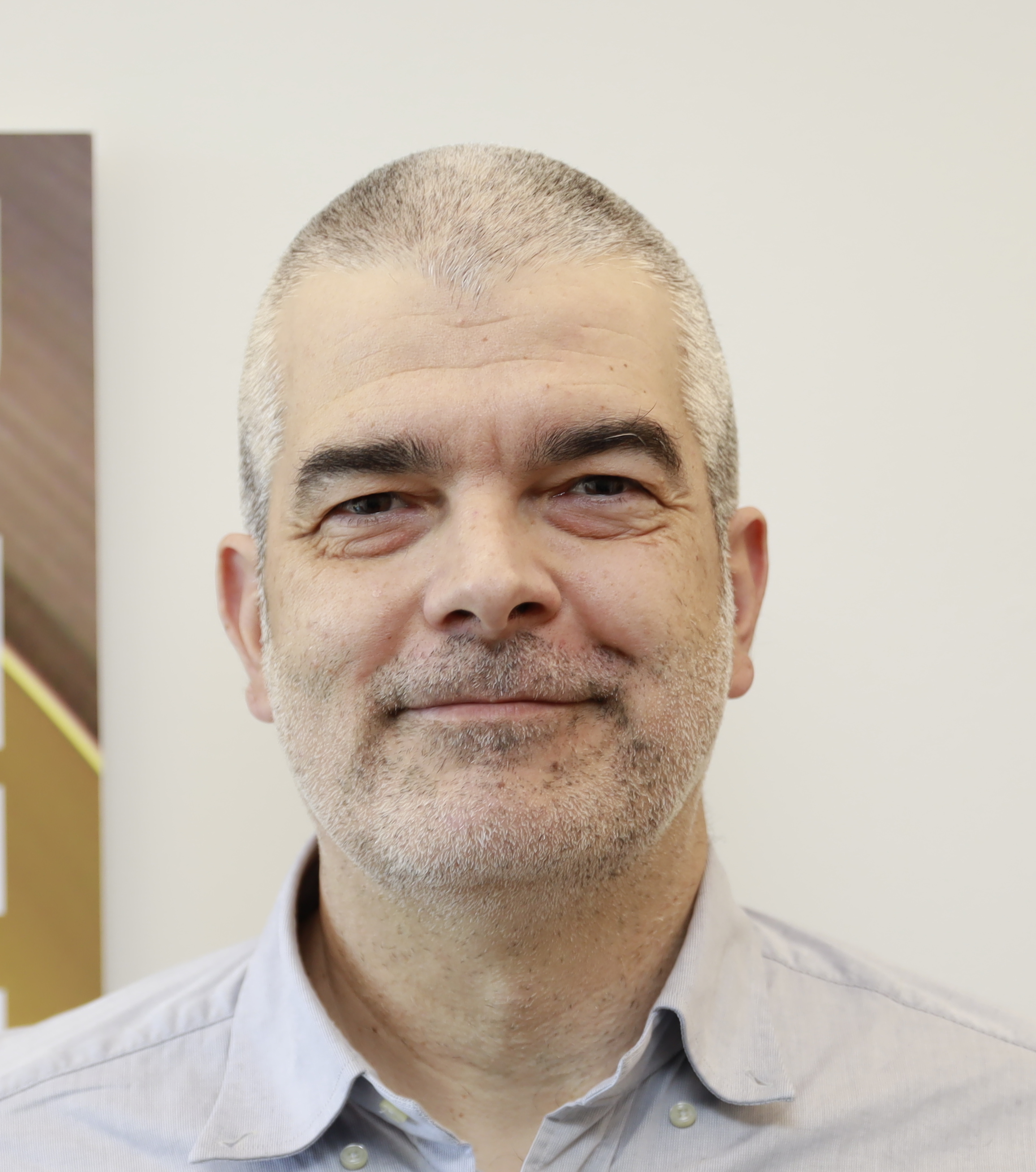Eric Brouzes, Ph.D.
Associate Professor
Lab for Microfluidics for Quantitative and Genomics Biology
Research Focus
 Analyzing heterogeneity of cancer tissues - It is increasingly appreciated that cells within a population, even derived from a
common ancestor, exhibit a high degree of heterogeneity. Cell subpopulations generally
arise from genetic mutations, epigenetic modifications or stochastic gene expression.
This heterogeneity underlines the importance of single-cell approaches that permits
the analysis of correlations that are otherwise obscured with techniques that collect
the average cellular response. The analysis of population heterogeneity is particularly
relevant to certain pathologies like cancer. Cancer development is generally described
as an evolutionary process where a cell population randomly acquires mutations and
natural selection acts on the resultant phenotypic diversity. This view has been recently
challenged by the description of stochastic gene expression that can induce transitions
between distinct phenotypes without genetic mutations. Hence, non-genetic phenotypic
variations may play a more prominent role in disease than previously anticipated.
Finally, cell phenotypes could be stabilized by cellular interactions and the loss
of these interactions could trigger stochastic gene expression and tumorigenesis.
These different models that try to reconcile the different data accumulated from a
few decades of molecular biology studies stress the importance of combining high-throughput
single-cell techniques with system biology approaches for studying cancer.
Analyzing heterogeneity of cancer tissues - It is increasingly appreciated that cells within a population, even derived from a
common ancestor, exhibit a high degree of heterogeneity. Cell subpopulations generally
arise from genetic mutations, epigenetic modifications or stochastic gene expression.
This heterogeneity underlines the importance of single-cell approaches that permits
the analysis of correlations that are otherwise obscured with techniques that collect
the average cellular response. The analysis of population heterogeneity is particularly
relevant to certain pathologies like cancer. Cancer development is generally described
as an evolutionary process where a cell population randomly acquires mutations and
natural selection acts on the resultant phenotypic diversity. This view has been recently
challenged by the description of stochastic gene expression that can induce transitions
between distinct phenotypes without genetic mutations. Hence, non-genetic phenotypic
variations may play a more prominent role in disease than previously anticipated.
Finally, cell phenotypes could be stabilized by cellular interactions and the loss
of these interactions could trigger stochastic gene expression and tumorigenesis.
These different models that try to reconcile the different data accumulated from a
few decades of molecular biology studies stress the importance of combining high-throughput
single-cell techniques with system biology approaches for studying cancer.
My research exploits the advantages conferred by droplet microfluidics over conventional
technologies and other microfluidics techniques in terms of automation, throughput
and combinatorial power for the manipulation and analysis of single-cells. We are
combining droplet microfluidics and state-of-the-art molecular techniques like next-generation
sequencing to conduct the genomic profiling of tissues at single-cell resolution.
This multidisciplinary project will have a direct impact on the basic science of cancer
and at the clinical level by improving the way cancer progression is assessed and
monitored.
Droplet microfluidics - Droplet microfluidics uses a 2-phase system, in which each assay is compartmentalized in an aqueous microdroplet (1 pL to 10 nL) surrounded by an immiscible oil. We generate droplets by forcing a central aqueous phase and two side streams of fluorinated oil through a small orifice (nozzle). The outer fluid exerts pressure and viscous stresses that force the inner fluid into a narrow thread, which then breaks inside or downstream of the orifice into droplets. The droplets are all of the same size (monodisperse) and are stabilized by a fluorosurfactant contained in the fluorinated oil. Droplets can be generated at up to 5,000 per second.
The droplet format has several advantages compared to single phase microfluidics: 1- it provides physical and chemical isolation eliminating the risk of cross-contamination; 2- reagents are quickly and efficiently mixed inside droplets; 3- droplets are very stable and can be incubated or thermocycled off-chip before being re-injected; 4- droplets can be manipulated at very high throughput. Droplet manipulations include pair-wise merging by electro-coalescence, mixing, on-chip incubation, fluorescence detection and fluorescence-activated sorting. Finally, droplet microfluidics presents a new paradigm for single-cell analysis. Experimentally, microfluidic chips are made of PDMS using soft-lithography techniques and flows are controlled by a pressure-driven system.
Education
- Postdoctoral: Genetics, Genetics Department, Harvard Medical School (Mentor: Norbert Perrimon), 2004-2006
- Ph.D.: Interface Physics-Biology, Universite Denis Diderot- Paris7, Institut CURIE, 1998-2004
- M.Sc.: Interface Physics-Biology, Universite Denis Diderot- Paris7, Paris, 1998
- Engineer: Physics,Ecole Superieure de Physique et Chimie de la Ville de Paris (ESPCI-ParisTECH), Paris, 1994-1998
Research and Professional Experience
- 2020 - Associate Professor, Dept. of Biomedical Engineering, Stony Brook Universty
- 2014 - 2020 Assistant Professor, Dept. of Biomedical Engineering, Stony Brook University
- 2011 - 2014 Research Assistant Professor, Dept. of Biomedical Engineering, Stony Brook University
- 2010 - 2011 Consultant, Metagenomix, Branford, CT
- 2006 - 2009 Senior Scientist, Raindance Technologies, Lexington, MA
- 2004 - 2006 Postdoctoral Fellow, Genetics Department, Harvard Medical School, MA
Publications
Publications via Google Scholar
Patent
- Blank K. G., Brouzes E., Frenz L., Griffiths A. D., “Microfluidic device for on-chip incubation of droplets in delay lines for droplet-based microfluidic assays, comprises a delay line allowing incubation of droplets flowing in carrier oil, and droplet fusion module in upstream of delay line.”, EU Patent Application # WO2010042744, filed on October 8, 2009 ; Rights owned by University of Strasbourg.
- Felix Kleinschmidt, Andrew David Griffiths, François Caron, Abdeslam El Harrak, Eric Brouzes, Darren Link. Microfluidic systems and methods for reducing the exchange of molecules between droplets. US Patent Application # US20130109575A1, filed on May 2, 2013; Rights owned by Raindance Technologies.
- Martin Sauzade, Eric Brouzes. MICROFLUIDIC device for true SINGLE-CELL encapsulation. #US20200094251A1
Course Taught
- BME 381 - Nanofabrication in Biomedical Applications
- BME 402 - Contemporary Biotechnology
- BME 590 - Biomedical Engineering Seminar
Funding Agencies
- National Institutes of Health - NCI, NHGRI
- National Science Foundation - CBET
- Simons Foundation
- Center for Biotechnology (New York State Center for Advanced Technology)
